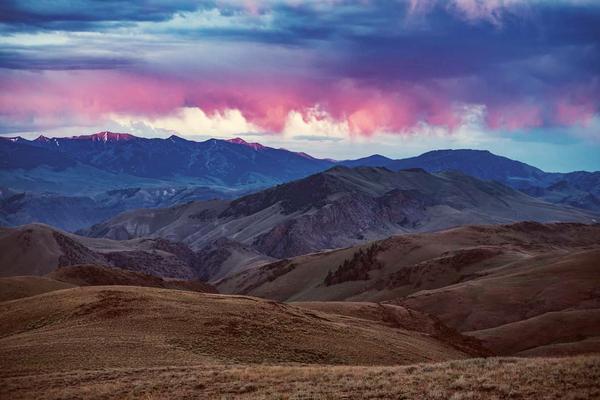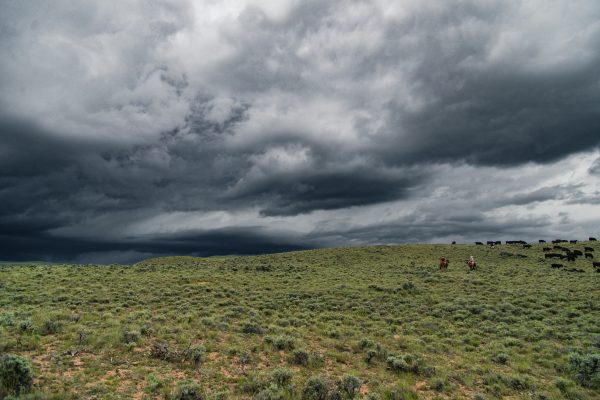 I was out feeding the beeves today on Alderspring’s snow-mantled meadows, as we do every day. They came running from foraging over the big pasture with their heads and tails held high (and often happily bucking) when they saw me show up with what I call “stored summer sunshine”. Other folks call it hay, but I think our hay is better because of its incredible species diversity and young stature (most ranchers around me try to harvest pure alfalfa or grass in a tall, but very flavorless life stage, in order to get more tonnage). Immediately after spreading hay, I’ll go back through the lineup as they put their heads down in the fragrant green, looking at each one to check for anything going awry. Winter in the High Pahsimeroi can occasionally be tough, with subzero nights and the occasional Arctic express frontal shift.
I was out feeding the beeves today on Alderspring’s snow-mantled meadows, as we do every day. They came running from foraging over the big pasture with their heads and tails held high (and often happily bucking) when they saw me show up with what I call “stored summer sunshine”. Other folks call it hay, but I think our hay is better because of its incredible species diversity and young stature (most ranchers around me try to harvest pure alfalfa or grass in a tall, but very flavorless life stage, in order to get more tonnage). Immediately after spreading hay, I’ll go back through the lineup as they put their heads down in the fragrant green, looking at each one to check for anything going awry. Winter in the High Pahsimeroi can occasionally be tough, with subzero nights and the occasional Arctic express frontal shift.
Those abrupt swings in weather conditions can easily provide the tipping point for a downward slide in health of any of our animals. That’s why we are careful to monitor all of them- cattle, horses, dogs, cats, chickens- closely on a daily basis in the winter in case they need special care. Although very rare, intervention could mean just getting separated from the big herd to get on better quality hay, or in a place where they will always be free from the wind. It’s most often in the older cows and horses that we see problems with maintenance.
There is one 16 year old mama cow, Ruby, that I am watching right now. She still has a nice set of twins that are nursing on her, and she has lost some of her luxuriant fat cover in trying to maintain lactation to two hungry calves. We may have to pull her from the herd and wean her babies. They are old enough to wean, but it goes against my instincts to wean them because I like to keep them on a little milk through the trials of winter, as nature has done with wild bovines for thousands of years before domestication. This pattern mirrors that of our native graziers- deer, elk, antelope, and bighorn sheep- all of which have their young in the early summer and wean their previous year’s baby in the spring when the green grass comes on.
My neighbors think we are nuts. Over the 22 years we have been in the cattle business, we completely circled back around to following the natural rhythms of seasons and cattle instinct that have meant success for bovines for millennia in the absence of human intervention. My neighbors, on the other hand, have categorically embraced production protocols that churn out weaned calves ready for waiting feedlot-bound semis in the fall.
The economic incentive for large, similar sized calves is very strong, for these are the kind of calves that feedlot operators are looking for. This means our neighbors calve at this Arctic time of year, synchronizing their breeding with estrus-inducing injected artificial hormones that cause all of those mama cows to calve in 30-45 day window. It means that they will have a lineup of very similar-sized weaned calves ready to load on the truck in 200 days, ready to go to a feedlot and eat carefully formulated feedstuff rations comprised of items the calves had never seen before like dry distillers grains (byproducts of ethanol production) to beta-agonists (weight gain enhancing chemicals).
The modern rancher would have met the triad of cattle industry values of fast, large and uniform. But high production comes at a cost: for the animal, for the humans that brave the winter cold to tend to calves born at an unnatural time of year, for the environment that is bombarded with the insults of an chemically based agricultural system, and finally, we believe, for the eaters of the beef. In our experience the system is unsustainable. High inputs mean higher management costs such as hormone implants, feed additives, and the subsidy of keeping fat on cows that have babies at very inhospitable times of year, like subzero nights in January.
It often is a study in extremes when we compare notes. Case in point: I was coming up the winding and icy Salmon River Canyon earlier this week, pulling my stock trailer after dropping off some finished steers at our new processor. It was night time, and had been for a while. A faint sliver of a crescent moon was the only light in the sky, but for some reason, the abrupt foothills along the Salmon River Breaks fairly glowed. I was stumped as to why that could be, until I rounded the next bend in the road.
I had to concentrate and force my eyes stay on the road, because I was fairly transfixed with a visage of Cow Hell. I could see quite a few black Angus cows under brilliant prison-type floodlights on this subzero night, in a large corral near the calving barn. They were confined so that they could calve under this artificial daylight with human observation. After all, a mom who drops a baby on a night like this has to get it up and nursing fairly immediately or have their newborn frozen to the ground. And if they have calving difficulties, which they often do in the stress of confinement, their baby could die in the birth canal. Human intervention can prevent this, but only at great expense: paying graveyard shift personnel, expensive facilities and lighting, and premium feed to support good lactation since there isn’t a blade of green grass to be found until springtime at this latitude.”‹
In contrast at Alderspring we don’t have much infrastructure- no calving barns, no feedlots, no floodlights. Winter is pretty quiet, and we let our cows calve in the spring, on green grass. We have found that if we let them calve at a time of year in sync with nature, we never have to check them at night. Alderspring mamas just go off and calve when they feel the birth process coming on, as their wild ancestors have for millennia. They find comfort in the darkness, cloaking them snugly in privacy while they concentrate on this, most foundational act in nature: having babies. For the past 5 years, we have not had to intervene with a single birth. The cows knew best, and the weather was warm.
The new gold standard in beef raising seems to be the term “grass fed”, as if it infers some holistic protocol that means healthy eating. Unfortunately, most grass-fed growers still raise cattle disconnected from how their beeves could function in a semi-wild existence. Our observations are that many grass fed producers follow most of production protocols that their grain fed neighbors embrace. The only difference often is that their grass-fed animals receive a non-grain ration when fed to finish.
“‹
Grass fed cattle may be in a feedlot for much of their lives. They may have been treated with hormones, antibiotics, or other growth stimulants. They likely have been treated with chemicals to eliminate parasites. They may be eating post-harvest GMO grain waste (like corn stubble or beet waste), or hay treated with pesticides. The grass fed label, while evoking pastoral images of cattle on grass, unfortunately does not require that the image equals reality.
For us, grass fed and organic is more than following protocols. Our goal is to mimic the natural system as much as we possibly can, because we believe that nature always wins and that if we work with it rather than try to control it, we as ranchers will win as well. Both Caryl and I were trained and worked as ecologists, and we find it very satisfying to take what we know about natural systems and try to continually move our ranching toward something that mimics natural complexity and biodiversity.
We have a long ways to go, but we are pretty excited about where we are and where we are going. There is an amazing potential for our wild and semi-wild western landscapes to produce nutritionally dense food for people while following an agricultural system that is sustainable over the long term and is in harmony with the other parts of our environment like wildlife, fish, water, and clean air. As we begin planning for a second summer of our new range riding effort, we get excited about the linkage between stewardship of these wild native mountain ranges and providing the best beef for people.
I think those folks that laugh at us miss out on an opportunity to raise healthier animals and better food, as well as creating a more sustainable enterprise for themselves. They are not letting the many years of genetic information to be expressed by their beeves for their greatest functionality, and we humans are left short with beef that is far shy of what it nutritionally could be had they raised it differently.
The irony is the pastured protein we raise here on Alderspring is called beef. I wish we could call it something else when I see what most raisers of beef do in their unnatural protocols; I feel we need something to differentiate and describe the difference between how our animals live and theirs. We need a word to describe the wellness to be found in the nutrition density and flavor of animal protein raised with wild nature of cattle in mind.
I guess we’ll call it Alderspring.
Thanks for making it part of your wild food choice. We so very much appreciate you.







Leave a Reply